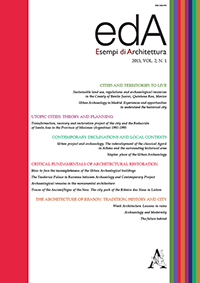Estratto da
ESEMPI DI ARCHITETTURA
International Journal of Architecture and Engineering
The Teodorico Palace in Ravenna between archaeology and contemporary project
ESEMPI DI ARCHITETTURA
International Journal of Architecture and Engineering
The Teodorico Palace in Ravenna between archaeology and contemporary project

The beautiful city of Ravenna keeps traces in its buildings of both a glorious past and a modern living. This symbiotic and conflictual connection is distinctly noticeable in the old town centre, where ancient architectures and new buildings still dwell together. This relationship becomes more complex where an archaeological site like the Teodorico Palace has to deal with a city growing above and all around it. As a matter of fact, the relationship between archaeology and urban spaces is often conflictual rather than synergetic. The fact-finding moment occurring during an excavation has to be transformed into a reason to promote and improve the city. When in the first decade of 1900 Gherardo Ghirardini and his team found the ruins of an ancient structure, they knew exactly it was the famous Teodorico Palace, seat of his power and home to marvellous mosaics which was named after him in medieval sources. Unfortunately nothing changed since then. The excavation area was recovered, most of the mosaics were brought to the National Museum of Ravenna, and the city kept growing over the ruins, leaving just a narrow park in the area, which also includes the Sant’Apollinare Nuovo Basilica and the San Salvatore Ad Calchi church. Our proposal is to bring the archaeology, with both its physical and symbolic evidence, back to the beating heart of the city and to make it the driving force behind urban rebirth and tourism promotion. Our project aims at making this heritage free to visit and walk through, thus promoting both a guided path and a spontaneous approach from the community, supported by the urban role of the archaeological site. This is the only way to correctly preserve, transmit and safeguard our common heritage, without feeling the stressful need to search abroad for what we keep hidden in Italy.
| pagine: | 83-94 |
| DOI: | 10.4399/97888548858688 |
| data pubblicazione: | Luglio 2015 |
| editore: | Aracne |








